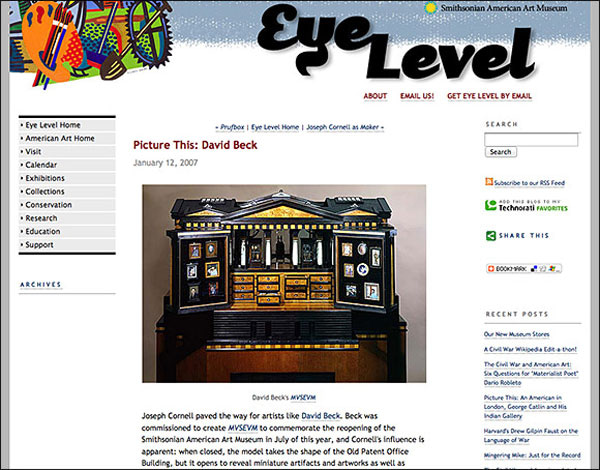
Case Study: New World Blogging Within a Traditional Museum Setting
This case study was first present at the 2007 Museums and the Web Conference. At the time, museum blogging was pretty new. I first proposed doing a blog for the American Art Museum in 2002 (I had been blogging on my own since 2001). But it was premature. With new bosses who understood the evolution of the web, I once again made my proposal two years later. This case study explains how we made this a reality.
In the fall of 2004, the Smithsonian American Art Museum’s (American Art) web team proposed creating a blog. The museum had been closed for renovation since January 2000 and would reopen in July 2006. Our web team wanted to connect our online content with our museum’s mission and soon-to-be galleries full of art. The goal was to engage our audiences in conversations, connecting their American experiences with the artworks in our collection.
A blog would be a very different type of web offering for American Art. New content would be produced at an accelerated rate, more than we were used to. Encouraging conversations with our viewers would require constant attention. As each museum office was gearing up for our reopening, there was concern about additional workload. How much time and what resources would this new project take? The web team believed the benefits of producing a blog outweighed the possible liabilities. We began to develop a project management plan that clearly defined the benefits, roles and responsibilities, subject matter, and workflow. Then we met with key staff and administrators to convey these details. Once the project was approved, we developed a pilot project to refine the scope and time constraints on museum staff.
In the year since we launched Eye Level to the public, we have continued to evaluate and expand story ideas, monitor workload issues, and refine our workflow to make it more efficient. Eye Level is a study in process and teamwork.
Why Publish a Museum Blog?
The Smithsonian American Art Museum’s main galleries had been closed for six and one-half years for renovation. Yet, we had been “open” on the web during that entire period. In those years, much had changed about web development in general and its relation to museum practice. With our reopening, we had the opportunity to use new tools to connect with our online visitors and connect our web offerings with our about-to-be-reopened galleries.
In addition, we saw an opportunity to strengthen our connection with younger audiences: twenty- and thirty-somethings who were getting much of their news and cultural information online. These young people would eventually become sixty and seventy-year-olds with cultural capital, time, money, and even art collections.
The blog was also a way to highlight our assets with high impact at a low cost. The project fit well with our museum’s mission to connect Americans’ experiences with our artworks. It reflected American Art’s tagline: “A destination museum for the 21st century.” Associating our collection and museum activities with the “blogosphere” would bring new audiences to our museum’s web sites. We wanted to use viral marketing to create a “buzz” as we readied the museum for its debut.
Proposing a Blog to the American Art Community

The original design of Eye Level
Our initial blog team included the Chief of Information Technology, the Head of New Media Initiatives, and myself (Lead Producer in New Media). As the authority on our collection, our Head Curator joined us to evaluate blog post ideas. Our Publications department would edit each post. (Note: At American Art, our web editor is in the Publications department.) Once the project was approved, we hired an outside contractor with blogging and art history experience to be our main blogger.
In early discussions within the blog team, we decided a well-planned approach to informing and educating our staff about this project was critical. We created a PowerPoint presentation to get initial staff feedback. We would need to get final approval from our Director, and these initial presentations helped us refine our scope and presentation. We could now anticipate questions and concerns.
We also wanted to address staff resources. As we were preparing for our reopening, all departments were very busy with their own projects. We needed to be sensitive to ‘adding yet another undertaking’ to everyone’s already full load. It was essential to show that we could sustain Eye Level with a limited amount of help from the rest of the museum.
The blog would build community, connect to our museum’s mission, and be a powerful marketing tool in a “conversational mode” rather than just a “broadcast mode.” Rather than just disseminating information, as had been the role of museums for most of the 20th century, we wanted to use the blog to encourage a dialogue with our viewers.
A Slow and Deliberate Rollout
We chose Six Apart’s Typepad as our blog content management system (CMS). It was inexpensive ($149/year) and offered free technical support. Most blog CMS’s require mySQL or php. The Smithsonian’s concern for security issues prevented us from using these alternatives (although Six Apart’s Moveable Type Enterprise edition now uses Oracle or SQL databases).
Once we hired our outside contractor and the blog was designed and functioning, we began to publish stories internally to the blog team. Our strategy was to move slowly. We wanted to become familiar with our publishing process. This allowed us to fine-tune our workflow and backend. After a few weeks, we opened the blog to all American Art staff for their feedback. Two months later, we went live.
The decision to publish Eye Level internally, indefinitely if need be, until everyone was comfortable with it, was necessary for overcoming early skepticism about how this project would function within our organization.
Workflow
We use Basecamp‘s Writeboard to publish each post for internal review. An author places his initial story on the Writeboard. Initial discussion by the entire blog team takes place there. When complete, it goes to our Publications department for editing. Coding and image preparation take place concurrently. After editing, the piece goes to our Director. As part of our blog team, our Director is in a unique position to offer insights into the subjects we are discussing, and this also allows her to become familiar with this new medium. Once the piece is complete, we place it in the queue for publication.
Anyone on the blog team can propose a piece. And we have had interest from other museum staff; for example, our lighting designer has written two posts about his work.
Some posts are timely, and these get priority, while others are more “evergreen” and can be posted at any time. Numerous issues can delay updating the blog, including not enough new content, long discussions about content, delays in editing, and waiting for final sign-off. The roles and responsibilities of each team member in this process are clearly defined. As Managing Editor, it is my job to keep an eye on each story as it makes its way through the workflow and juggle publication schedules when necessary. I notify our Chief when the story is ready to go up to the Director, and he passes it on to her.
Our initial goal was to publish at least two posts a week. During our first full year, we exceeded our goal by publishing 108 stories.
Story Ideas: Changing as the Situation Warrants
Defining the parameters of our blog before we started publishing was important. What did we want to talk about, and how did we want to talk about it? An early definition of a blog (circa 2001-2004) was a site with frequent informal postings with links to other blogs and websites. Back then, the blogosphere hotly debated this definition. Could storytelling and journal sites be blogs? This debate has since subsided in the general community. Now a blog can be anything and in any form.
Early on, we decided our workflow could not support quick, spontaneous blog posts that react to current events. More like The New Yorker than The New York Times, our stories would offer fewer current events and more reflective art and museum practice pieces. We wanted to convey a sense of quality about what we said. In their book Naked Conversations (2006), Robert Scoble and Shel Israel (2006) suggest showing your passion and authority when blogging is a way to be successful. Our goal was to bring a thoughtful behind-the-scenes look to what was going on as we prepared for reopening, promote discussions on artists and American art, whether it be here or elsewhere, enlarge our audience, and connect our content to the blog social network.
While our initial proposal was to do two posts a week, the one major exception was the weekend we reopened. We decided the event demanded we blog live on July 1 and July 2, opening weekend. We moved blog central from our offices across the street from the museum to a room within the museum. Our blog team grew to include others from our department, and with high-speed net access, we even hosted other outside bloggers covering the event. During the opening weekend, we blogged eight stories.
After the museum opened, we shifted our attention to a new reality: we were no longer ramping up to reopen. We were open. So we had to refocus on new ways of writing about American Art. We discovered we could say a lot very succinctly with a photograph and a short caption (which shortened the story’s development time). We started a new category with these photos called Picture This and adjusted our workflow to create “quick” posts.
After we opened, we had two new and very unique centers in the museum: The Luce Foundation Center for American Art, an open study/storage facility displaying over thirty-five hundred objects from the collections of the Smithsonian American Art Museum, and The Lunder Conservation Center, an open conservation lab. We included photographs of conservators working on artworks in Picture This and began a new feature called “In This Case,” highlighting interesting objects found in our open storage area. This was a way to bring interesting aspects of our museum to the surface.
PR versus Insightful Content
In blog posts about the American Art Museum, a fine line can separate interesting content from press release-type posts. If Eye Level were seen merely as a PR tool, our community would start taking note and losing interest. By defining our blog’s parameters from the outset, we can scrutinize each post as it develops to navigate this fine line. We strive to be authentic, truthful, and transparent, use a human voice, and talk about and link to other museums whenever possible.
Controversy
Controversy is an inevitable part of blogging. But there are ways to be prepared for it when it occurs. We moderate comments on Eye Level; this allows us to view them before they go live. We developed a comment policy before launching the blog and state it clearly on each comment page. Critical comments are published, and we reply to them online, even if it is to say we will think about it and respond in more detail later. This gives the commenter the feeling we are responsive and gives us time to decide how best to address the issue. We delete trolls. If a comment is confusing, we will contact the writer for clarification. With the writer’s cooperation, we can edit their comment for clarity.
The comfort level of your organization will determine the controversial limits you will be able to tolerate. Think about this zone when you are first defining your blog. Discuss it with administrators and others on your blog team. Limit surprises by being prepared.
Managing Editor: A Necessary Position?
Adding Managing Editor to my job description was not part of our initial plan. But as project manager, I was in the best position to coordinate the numerous aspects of an organizational blog. This part of my job takes from 30% – 40% of my time. It includes running editorial meetings, creating blog post schedules, updating the team weekly on where each blog post is in the workflow, moderating comments, researching and formatting images, and alerting our team whenever there is a bottleneck.
Depending on the nature of your institutional blog, you may or may not need a managing editor. If you decide to make it more open-ended, simple rules for posting might suffice. But someone should monitor your blog’s posts and comments.
Connecting to the Social Network (Web 2.0)
Connecting to the social network is one of the main reasons we started a blog at American Art. We were hoping to create an area of our website where conversations about American art could occur. And there are several methods for connecting to this network of people interested in what we have to say.
Creating RSS feeds helps more readers access your information. Tagging posts via social network sites like Technorati, Flickr, and del.icio.us allows for greater visibility. Through networks like these, Eye Level is linked to by over 500 other blogs. This is huge for a cultural blog like ours and further proof that we are successfully connecting to this network.
In our first year, we had over 127,000 visitors to Eye Level. We invested in a good statistic program. It is inexpensive (about $55/year), and we can see where our readers are coming from and who’s linking to us. We use Feedburner (http://feedburnder.com) to monitor the number of people subscribing to our blog via RSS. While we are still deciphering stats (what is the best metric: visits or page views, for instance), they give you and your administration one benchmark for success.
We are still trying to determine why specific posts result in many comments while others do not. Our two most commented-upon posts were on the contemporary artist Dana Schutz and the Noguchi Museum’s exhibition, The Imagery of Chess Revisited. Schutz’s piece had already been a topic of discussion in popular culture because of recent coverage in Vogue and debates within the art community. In the second case, the large numbers of chess players today must have brought in a crossover audience that accounted for the boost in the comments on the Noguchi exhibition.
Through our stats, we get to know our readers. I’ve often written comments on referrer sites or spoken with them directly. All these methods help develop relationships with others interested in your field. This connection is at the heart of the net social network.
Conclusion
Eye Level began as an attempt to:
- Connect our artworks to the American Experience in a new way
- Create a dialogue between our web offerings and our bricks and mortar activities
- Create interesting new web content on an ongoing basis and in an efficient manner
- Allow viewers a behind-the-scenes look at what takes place in our museum
- Connect to Internet social networks to enlarge our audience and ultimately bring people into our museum
We attribute our continuing success to adopting a process that allows for growth and connects Eye Level to the changing roles of our museum at the beginning of the 21st century. In many ways, our experience has led to more questions than answers. How can we reach out to an even wider audience? What tools can we adapt for this to take place? If our blog is the first step in this new engagement with our communities, what will be next?
References
Scoble, R & S. Israel, (2006). Naked Conversations. New Jersey: John Wiley & Sons, 175
Cite as: Gates, J., Case Study: New World Blogging within a Traditional Museum Setting, in J. Trant and D. Bearman (eds.). Museums and the Web 2007: Proceedings, Toronto: Archives & Museum Informatics, published March 1, 2007, Consulted March 20, 2013. http://www.archimuse.com/mw2007/papers/gates/gates.html
Read more: Archives & Museum Informatics: Museums and the Web 2007: Papers: Gates, J., Case Study: New World Blogging within a Traditional Setting http://www.museumsandtheweb.com/mw2007/papers/gates/gates.html Under Creative Commons License: Attribution Non-Commercial No Derivatives

© 2007-2021 Jeff Gates. This work is licensed under a Creative Commons Attribution-NonCommercial-NoDerivs 4.0 License.


